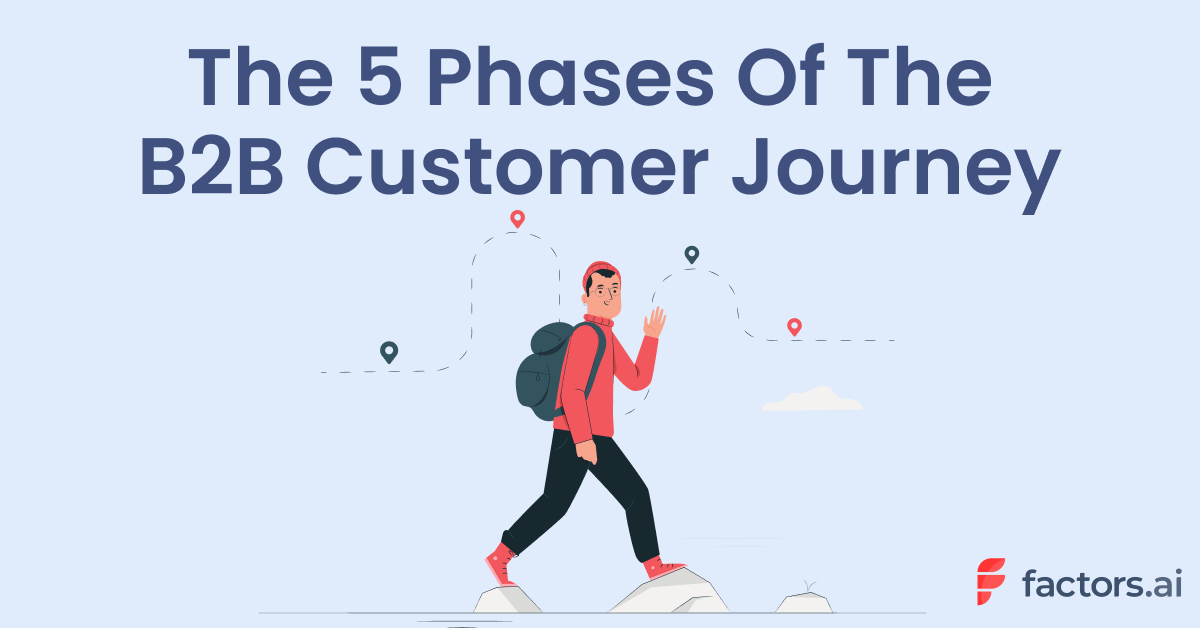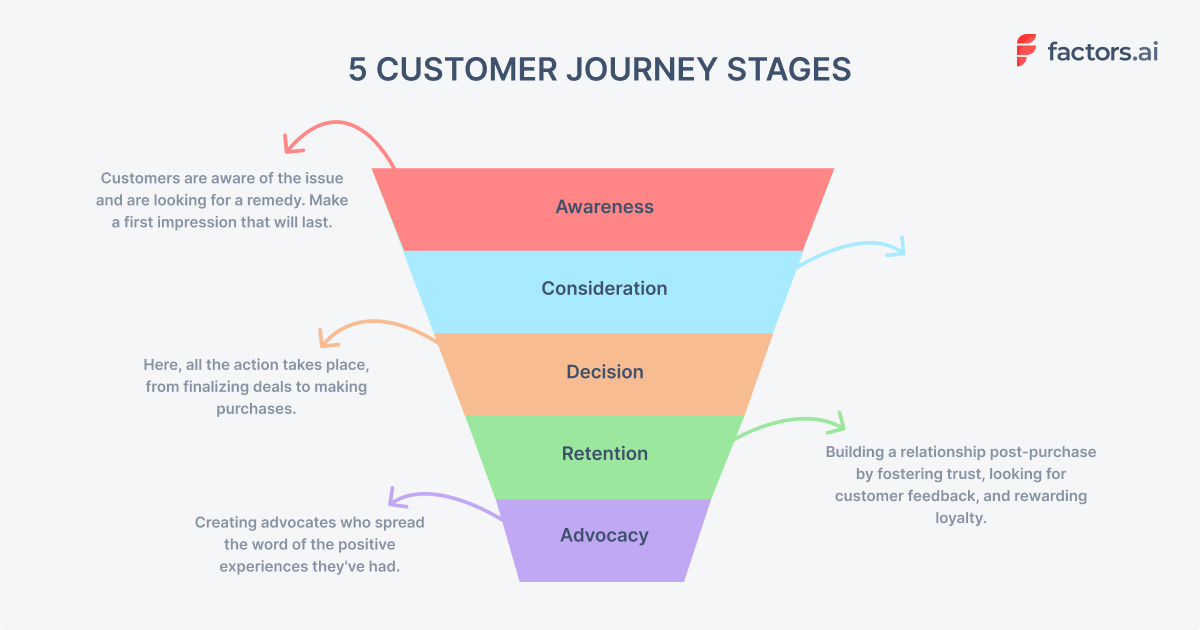The 5 B2B customer journey phases: How to provide value along each step
 Factors.AI
Factors.AITable of contents

Customer journey phases
Customers are more likely to remain loyal to a company if they receive consistent value and an enjoyable journey. In other words, how well do you know your clients? Unless you do, it will be difficult to satisfy their needs and provide memorable experiences.
A lot of companies fall short because they don't put in the effort to learn about their customers and their journey.
The B2B customer journey consists of numerous touchpoints that influence the customer experience. In order to properly plan your customer service and marketing strategies, it is essential to comprehend complexity. Once you understand the customer journey stages, you can take action and provide value at each stage.
In order to create a successful B2B customer journey, it is essential to have a strategic plan in place, in addition to the efforts of a dedicated team. Nevertheless, it is easier to say than to do. In actuality, marketers must go the extra mile to ensure the ease of the B2B customer journey.
In this article, we will discuss the various B2B customer journey phases and how to deliver value at each stage.
Definition of B2B customer journey
From the first point of contact to long after a purchase has been made, the customer has a series of interactions that make up what is known as the "B2B customer journey."
Now imagine a B2B purchaser who learns of a SaaS provider that meets their unique requirements. Even still, before making a final decision, there are many steps a buyer will take. Even after the deal is won, there's usually an onboarding process to ensure that the product is being used to its full potential. All of this constitutes the course of a customer's journey. What ultimately defines the all-important customer experience is the impression made along this journey.
Stages of Customer journey
The buyer’s journey can be divided into distinct customer journey phases. Each stage indicates a buyer’s position in the decision-making process. In the sections that follow, we’ll go into greater depth about each one.
The number of customer journey stages varies depending on the source of information. We can divide the process into five steps, as depicted in the image below.

The 5 phases of a B2B customer journey are:
- Awareness
- Consideration
- Purchase
- Retention
- Advocacy
Depending on the nature of the enterprise, these stages may be more or less distinct. Some businesses, for instance, might need you to go through an onboarding process before you can make a purchase from them.
Surprisingly, only 17% of this time is spent in direct conversation with the vendor, according to Gartner's 2019 Future of B2B Buying Journey Report.
The rest of the journey is made "behind your back," in the form of research and internal deliberation. That's why it's crucial to provide buyers with high-quality content that answers their questions and concerns at each stage of the buying process.
For each phase of the B2B customer journey, we need a plan. This allows us to meet prospects where they are in the purchasing decision process. This strategy will also enable you to maximize every opportunity to acquire customers.
Here’s an example: Creating an ad to sell a $500 product will attract prospects in the Consideration stage. These individuals are currently searching for a solution to their problem.
However, not all who view the ad will be in the Consideration stage. Those who have never heard of you are unlikely to purchase your product after seeing one of your ads for the first time. In this case, the ad simply introduces the audience to your brand.
These non-buyers are instead in the Awareness phase. In fact, they just "met" you through your ad campaign. After getting to know you and your work better, they may eventually be interested in what you have to offer.
But what do you do with these individuals in the interim?
You can continue to engage people in the Awareness stage if you have a plan for them. If none exists, each of these prospective buyers represents a lost opportunity.
Planning for each stage of the customer journey enables you to send the appropriate message to the appropriate individuals at the appropriate time.
Let's now examine each stage of the customer journey in detail.
1. Awareness Stage
This is also known as the "connection" stage of the customer journey. This category of prospects discovers your company through a variety of channels: Social media, advertisements, and word-of-mouth to name a few.
These potential purchasers know nothing about you and your business or product. You are responsible for informing them of what you do and how you do it. The objective is to increase interest in your product/brand and demonstrate to prospects how you can assist them.
Look for folks who are the best fit for your product or service when determining which audiences to target. This will allow you to target only those with a greater degree of buying intent.
What does "buyer intent" mean?
Buyer intent predicts how likely a potential customer is to go through with a purchase. Interest is good, but it doesn't guarantee a sale 100% of the time. This is why it's crucial to narrow down potential customers at the initial stages of the sales process.
It's possible that some individuals will be curious enough about your work to "check it out." But that doesn't make them a legitimate prospect for customers.
Classify your target market into three categories: low, moderate, and high interest. Determine what you can do to get the most expensive customers first. The following are examples of questions that might interest them:
- Can I get a free trial version?
- Can you tell me about the several versions that exist, and how they differ from one another?
- Where are the reviews or even testimonials?
Those who are only mildly interested will want to see more proof before making a final choice to buy. Their concerns may take the form of, for instance:
- So, what makes you special?
- Where can I get examples of your work and/or customer feedback?
If you had to choose between the price and the worth of the product, which would you choose?
Low-intent buyers may not be a suitable fit. On the other hand, once they see what you can do for them, they may become a paying customer. In order to break through this resistance, you should emphasize the connection between their problem and your solution.
Your role as a marketer throughout the Awareness Phase: Demonstrate that you UNDERSTAND the prospect's problem and offer knowledge and resources to assist them in better navigating their problem or requirement.

2. Evaluation & Consideration stage
The customer's journey then advances to the Consideration phase. Your potential customers have likely already done some preliminary research and have a basic understanding of what they may expect. The investigation process, however, is still ongoing. They have eliminated certain possibilities, but they will continue their research.
At this point, they are weighing your offering against that of competitors. Wherever your potential customers spend the most time online is where they are performing research into your product or service, including looking at prices, reading reviews written by other customers, researching the product, and learning more about its features and benefits. Since this is the point at which the customer is deciding between you and the competition, it's crucial to step back and assess whether or not you're positioned as favorably as possible.
Here are some questions you need to ponder about in this stage:
- Are the benefits of my service or product easy to grasp?
- Can people quickly locate my business online?
- When using my product or service, are I able to clearly see the benefits?
- Is the cost of my service or product reasonable in comparison to alternatives?
- To what extent do I excel in comparison to the competition?
- Is my unique selling proposition presented in a way that a customer can quickly identify it and grasp it?
Many potential customers will initiate contact with you at the Consideration stage by filling out a contact form, dialing a phone number listed on your site, or interacting with you on social media in order to learn more. Don't leave them hanging!
Now is your chance to be the answer to their prayers and the balm to their wound. At this point, prospective customers have a lot of questions about the costs involved with using your solution. Your potential customers will likely need to discuss this information with others before making a purchase from you.
Your role as a marketer throughout the Consideration Phase: To persuade the customer that your company’s product or service is the best choice for them and to arm them with all the knowledge they'll need to make a final buying decision.

3. Purchase/Decision Stage
The third step of the customer journey is the Decision stage, during which your prospective customer is prepared to choose amongst available options and complete the transaction. The prospective buyer has conducted all the research necessary to be well-informed about which services would best meet their demands and which companies they consider to be the greatest match. At this point in the customer journey map, customer feedback is critical.
Most prospective clients in the B2B sector look for two things before purchasing a product/service:
- Risk-Free Trial
- A Live Demo
But what if neither of the options applies to your product or service?
In such an instance, you'll need to rely on a variety of information to instill trust in potential buyers. Showing them social proofs or reviews is the simplest way to alleviate their doubts and possibly gain their trust.
Since buyers are increasingly relying on peer-to-peer recommendations, the absence of feedback for your product or service could potentially have a negative impact.
Providing case studies to your prospects at this stage is highly advantageous and will address the question on their mind, "Why should I choose you?" When a customer is in the Decision phase of the buying process, it is critical to demonstrate your product's value through testimonials and reviews. Solicit testimonials from existing customers and feature them on your website and other locations where prospective clients will be looking for information about you, your business, and your services.

4. Retention/Loyalty stage
Customer Retention is the fourth step of the customer journey. Congratulations! If your consumers have made it this far, you must be doing something right. But it isn't over yet. Indeed, this is likely the most critical step of the customer journey. Why?
Just because someone purchases your product does not mean their customer journey is complete. You want them to be repeat clients who come back to you when they have new difficulties or when your product expires. This stage isn't always applicable to all product categories, but if you value repeat customers, you'll want to include a stage in your customer journey that evaluates why customers return and what techniques you may use to engage them.
Your product is one of the most powerful touchpoints you have in the loyalty stage. The more someone relies on, appreciates, and uses your product, the more likely they are to become a devoted customer.
You can also reach out to them through packaging and follow-up messages. You may welcome them to incentive programs, seek reviews, or even upsell them with add-ons and related products via these channels.
If you have an appropriate communication channel, such as an email list they subscribed to, you can build loyalty by offering materials that help customers optimize the value of their purchase, or simply sending them coupons and special discounts.
You don't want them to only buy from you once. You want them to return and trust you as a leader in your industry.
Retaining a current customer is significantly easier and nearly five times cheaper than acquiring a new one. It takes a lot of trust to convert a prospect into a first-time purchase, so once you have their confidence and business, you should work hard to keep it. You should be following up with your client at this point to acquire their opinion on the product or service that they purchased from you. It always helps to thank them for their patronage.
The below illustration shows the type of content you can deliver in this stage:

5. Advocacy
The final step in the customer journey is also the most challenging. At this point in the customer journey cycle, the customer has decided to become an active advocate for your product/service or your brand.
However, clients will only rave about your product or service if they are genuinely pleased and satisfied.
In fact, satisfied customers frequently recommend brands to others. Therefore, you must now consider measures to promote customer loyalty to your brand.
Therefore, if you want customers to become brand advocates, you must:
- Observe them
- Give value
- Display respect
- Ensure excellent experiences
- If they have an issue, fix it.
Advocacy can be cultivated in a number of ways, including through campaigns that encourage user-generated content, such as a photo contest, or through providing exceptionally helpful tools that teach customers how to solve problems and achieve goals. It is also possible to gain advocates by surveying your audience and asking for comments. Some of today's most successful businesses rely heavily on referral and word-of-mouth marketing.
How Can Customers Be Reached During the Advocacy Phase?
- Create a simple and rewarding referral program to encourage customers to suggest others to your products or services.
- Display the thoughts of consumers on the website or on social media to persuade prospective purchasers to make a purchase.

A PRO TIP for you!
Too often, go-to-market teams view the customer journey (exclusively) via their funnels.
Don't do it.
The actual customer journey should not be confused with the go-to-market funnel.
The go-to-market funnel is linear and artificially segmented into stages, whereas the B2B customer journey resembles a winding river with numerous tributaries (stakeholders within the same account) flowing to and from it.
Focusing on the most relevant stages of the journey is helpful for operationalizing efforts, but it is not particularly useful for comprehending the customer journey.
Both sales and marketing teams must be able to identify the source of leads and their progression through the sales pipeline.
Create Your Own Analytics Dashboard for the Customer Journey Stages with Factors
In order to help you analyze the customer journey from beginning to end, Factors is equipped with a wide variety of features. By using Factors, you can track and display where your customers are in the various phases of the buying process, for instance, how many users progressed through the journey's checkpoints and how many eventually gave up can be viewed in real time. If something goes wrong at any point in your customer's journey, you'll know about it right away and be able to fix it. Using the User Timeline feature of Factors, your marketing team can find the details of what your users are doing most of the time on the website by checking the history details of the user, so that you can attract more users on the specific page or action where most of the users fall in.
Another great thing about Factors for customer journey analytics is that it automatically gathers and stores all the metrics you'll need to analyze data from each stage of your customer journey as it happens using the Account Timeline feature. You can create your own dashboards and track any metrics you like. Because Factors handles everything for you, you'll have more time to focus on growing your business. It's exciting, right?
What are you waiting for if all these convenient features meet your expectations and pique your curiosity? Start leveraging the power of customer journey analytics immediately by signing up for a free trial of Factors here.
Subscribe to my newsletter
Read articles from Factors.AI directly inside your inbox. Subscribe to the newsletter, and don't miss out.
Written by

Factors.AI
Factors.AI
The best B2B Marketing Analytics & Revenue Attribution tool